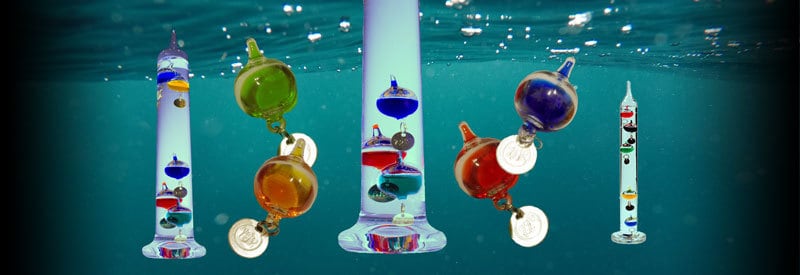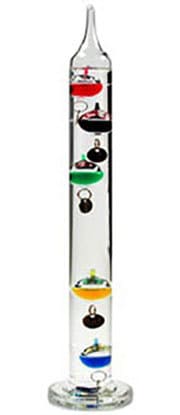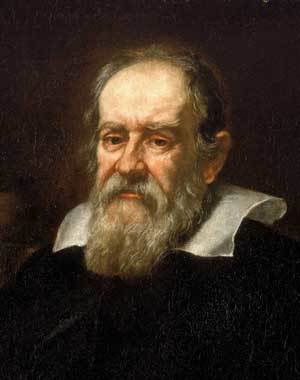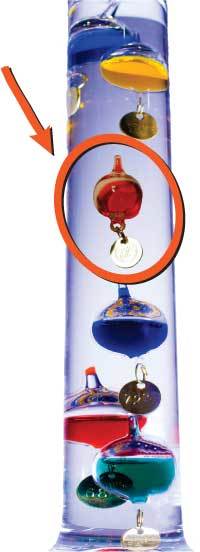The Galileo Thermometer – What It Is And How It Works

Today, meteorologists use a wide range of instruments to measure ambient air temperature. Centuries ago, much simpler and, at times, "interesting" devices such as the Galileo thermometer were used.
A Galileo thermometer is defined as a meteorological device consisting of a sealed glass tube filled with a clear liquid containing small glass bulbs of varying densities. Ambient temperature changes alter the fluid's density, causing different bulbs to rise or fall, which indicates the temperature.
Although this specific thermometer as we know it today wasn't designed by Galileo himself, all the principles that the thermometer is based upon were discovered and implemented by Galileo Galilei and his thermoscope.
Galileo Thermometer Definition
Before delving into the inner workings, though, we first need to define what precisely a Galileo Thermometer is:
What Is A Galileo Thermometer?
A Galileo thermometer is a meteorological instrument consisting of a sealed glass tube filled with a clear liquid containing small glass bulbs of varying densities. Ambient temperature changes also alter the liquid's density, causing different bulbs to rise or fall, which indicates the temperature.
Each bubble is partially filled with a different colored liquid. Small metal tags of different weights are also hanged below each bulb to adjust their "density," while each tag also contains a number.
Any changes in air temperature change the density of the liquid as well. This causes the bubbles inside the liquid to rise and fall in response to changes in the fluid's density.

By observing the different heights at which the glass bubbles are floating, the temperature can be determined. This is done by identifying the number of the tag below the bubble floating at the "right height."
If this sounds confusing to you, you are not alone. If I only described to you what a Galileo thermometer looks like and how it responds to temperature changes, it would be difficult to understand what is really happening and why.
One needs to understand the principles and forces at work that make all the parts in this thermometer behave the way they do and how they all work together to help determine the atmospheric temperature.
The first priority, therefore, is to make sure every principle is fully explained and understood. And that will be the focus of the next section.
(If you are familiar with these principles or want to skip all the technical jargon, you can jump over the next section and move directly to the section explaining how a Galileo Thermometer works.)
The 3 Principles Of A Galileo Thermometer
In order to better understand how a Galileo Thermometer works, one first needs to clarify three principles to make sure you understand how they influence the individual components that form part of the thermometer:
- Buoyancy: Many explanations of the Galileo Thermometer start by emphasizing the fact that the instrument works on the principle of buoyancy.
- Density: The Galileo Thermometer is named after the scientist, mainly because it is based on his formulation of the principle that the density of a liquid changes in proportion to its temperature.
- Gravity: Gravity plays a major role in the downward pull of all objects. This is especially important for the Galileo Thermometer to operate correctly.
So which one of these three principles is the Galileo Thermometer based on? Actually, all three principles play an equally important part in making it work.
The best way to understand the relevance and importance of all three principles is to see how each one works and its role in making the Galileo Thermometer work.
1) Buoyancy
Buoyancy is the upward force or thrust of a liquid on an object submerged in it. It is the very principle that all vessels designed to float on top of the water are based upon.
It is very closely related to the principle of density. Density is probably the most significant factor that determines an object's buoyancy.
A simple example will illustrate how this works in practice. Take a tennis ball or football, and try and push it underwater in a bucket or bathtub. What happens?
It immediately starts resisting your action and shoots to the surface as soon as you release it. This is because the density of the air in the ball is so much less than that of the water.
Now try and do the same with a heavy piece of metal like lead. You will immediately notice that you do not experience any "pushback" from the water while you submerge it.
If you release it, the piece of lead drops to the bottom. The metal's density is so much greater than that of the water that the "upward force" of the liquid has very little effect on the lead's downward movement.
As you just observed, the density of an object compared to that of the liquid, it is submerged in determines its buoyancy (ability to float).
2) Density

Galileo Galilei
Although the original inventor/s of the Galileo Thermometer is unknown, it is named after the legendary scientist due to his discovery that the density of a liquid responds to changes in temperature.
The Galileo Thermometer may be a much more complex instrument, but it is based on the thermoscope that Galileo invented as a result of his theory.
Although most of us understand what density is, it is a bit harder to define in words. ScienceDaily.com puts it best by describing "density as mass per unit of volume."
This means the density is closely related to an object's mass. But mass has to be put in context by equating it to its volume (physical size).
Technically, density can be calculated by dividing mass by its volume.
This is best understood by seeing in practice. Let's use the example of a piece of iron of a certain size. Now compare that to a piece of foam of exactly the same size.
Clearly, the piece of iron is much heavier than the foam. This is because it has a much higher density than the similarly sized foam.
We can easily prove this by using the equation to calculate density: Density = mass/volume.
Let's say the piece of iron weights 2000 grams (4.4 pounds) and the foam weights 200 grams (0.44 pounds). We already know they have the same volume (size), for example, 20 square centimeters (0.31 square inches).
Do the calculation, and you will see that iron has a much higher density of 100 cm³ compared to the 10 cm³ of the same size foam.
Simply put, if two solid objects of the same volume have different weights, the heavier object has a bigger density.
3) Gravity
Gravity is the Earth's force that pulls all objects in the atmosphere towards its center, regardless of the mass and shape of the object. The strength of the gravitational pull on an object is described as its mass.
Gravity impacts every single object on earth. Every one of you is aware and experiences gravity every single every day (sometimes in a very unpleasant way, especially when you lose your balance and fall from a considerable height).
It should come as no surprise then that gravity plays a vital role in the functioning of a Galileo thermometer. It is the constant battle between density and gravity that determines the glass bubbles' buoyancy in a liquid-filled tube.
Now that all the principles and forces at work have been explained and are out of the way, it is time to see how they all work together to make a Galileo Thermometer work.
How Does A Galileo Thermometer Work?
From the description earlier in this article, you already know what a Galileo Thermometer looks like and what it consists of.
What you may not realize is that each of the colored glass bubbles in the liquid is approximately the same density. It is the numbered metal tags hanging below each bubble, that changes the "density" of each globe.
The individual tags each have a different weight that corresponds to the number on them, which shows the specific temperature each glass bubble represents.
From the previous section's explanations, you will also know that it is the density of objects in a liquid that determines its ability to float (their buoyancy). And it this very principle that makes a Galileo Thermometer works.

Each glass globe in the thermometer has a different density. Some bubbles are the same density of the water they are submerged in at a specific atmospheric temperature. The other globes all have different densities (read mass), varying from slightly to substantially lighter or heavier than the density of the water.
It is important to remember that air temperature directly influences the density of water. If the temperature increases, it warms up the water, making it less dense. If it decreases, the air cools down the water, making it less dense.
The glass globes inside the liquid respond to this change in the water's density. Some bubbles that are now less dense than that of the water will start to rise to the top. At the same time, the bubbles with a density lower than that of the water will begin to sink to the bottom of the tube.
The glass bubbles, which now have the same density as the surrounding water, will be floating around halfway between the ones at the bottom and the ones at the top. These glass bubbles in the middle are the ones that show the actual air temperature at the time. (As indicated by the number on the tag).
And that is how the Galileo thermometer works. It is a simple-looking process, but as you have learned, with a lot of different forces at work behind the scenes.
As the air temperature keeps changing, the glass globes continue to change their height in the liquid to adjust to the water's density.
Conclusion
Although not being used for meteorological purposes anymore, it is easy to see why Galileo Thermometers are still so popular. They are not just beautiful to use as ornaments, but the constant movement of the glass globes inside the water makes them fascinating to watch.
It also helps that, despite its fairly rudimentary and dated mechanisms, it is still surprisingly accurate compared to modern state-of-the-art thermometers.
You can find out more about specific Galileo Thermometers and other interesting meteorological instruments in this article.
Never miss out again when another interesting and helpful article is released and stay updated, while also receiving helpful tips & information by simply clicking on this link .
Until next time, keep your eye on the weather!
